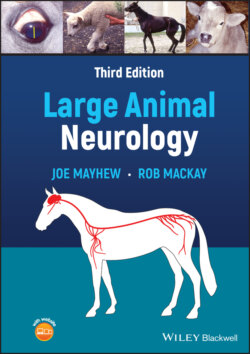Читать книгу Large Animal Neurology - Joe Mayhew - Страница 44
Interpretation of signs of spinal cord disease Gait and postural abnormalities
ОглавлениеMusculoskeletal and painful disorders causing gait and postural disorders are far more commonly encountered in large animals than are those involving just the nervous system (Figure 2.13). Thus, two questions to be answered when evaluating gait and posture are, first, which limbs are abnormal, and second, is there evidence of lameness suggesting a musculoskeletal or painful component of any gait or posture abnormality?
Figure 2.13 Heavy patients with various neuromusculoskeletal disorders can have difficulty rising. Such patients, especially ruminants and pigs that adopt a dog‐sitting posture for several seconds to minutes while getting up, usually have lesions caudal to the thoracic limbs and to T2. However, adult ruminants are seen to rest in the field in such a posture without having an overt neuromusculoskeletal explanation. Also, occasionally patients such as this horse suffering from mild caudal cervical spinal cord compression caused by CVM may also adopt and maintain such postures. This horse was also a tongue sucker (see Chapters 5 and 18).
In other words, non‐neurologic problems should be always considered as being a component of any gait abnormality, and these often confound interpretation of gait and posture evaluation.
The essential components of neurologic gait and postural abnormalities are paresis and ataxia, and considerable effort needs to be made to define the presence, characteristics, and severity of these findings when evaluating patients suspected of suffering neurologic disorders. In our experience, the most frequent mistake made in observing for, describing, and teaching about characteristics of gait and postural abnormalities is failure to describe accurately what is seen, before interpreting what any abnormalities might represent. Thus, we do not see ataxia, weakness, lameness, and pain, but we do see irregular and unpredictable foot placement, toe dragging, head nodding, and abnormal postures, respectively, that can be interpreted as such.
It is important to firstly describe in non‐technical terms exactly what is abnormal with gait and posture before interpreting changes as being due to ataxia, weakness or lameness.
Paresis or weakness can be defined as poor ability to initiate a gait, to maintain a posture, to support weight of the body or its parts, and to resist gravity. Often it can be determined that such weakness is predominantly involving extensor or flexor muscle groups or both. As a generality, extensor, antigravity weakness is most indicative of final motor neuron paresis. Dependent on where the lesion is, this is often seen as a bouncing gait with a short‐stride length, trembling, buckling and bunny hopping, and a lowered neck carriage. This can result in an apparent weight‐bearing lameness due to the exaggerated head nodding, particularly when it is asymmetric. For clarification, bunny hopping is a nonspecific gait characteristic, more often seen with musculoskeletal disorders. When representing paresis, bunny hopping likely reflects the added weight support offered when two limbs are used together.
In distinction, central motor pathway paresis is often seen as a delay in initiating movement, therefore usually involving flexor muscles. Thus, a slow onset of the protraction or swing phase and a swinging, longer stride with decreased joint flexion (degrees of hypometria) are characteristics of central motor pathway paresis. Paradoxically, patients with this kind of weakness retain strong reflex extensor tone and strongly resist against dorsal pressure, thus often being described as spastic paresis.
Based on this, with a prominent C6–T2 lesion involving gray and white matter in a smaller patient, one can see a very characteristic gait whereby there is a short‐stride, bouncing gait in the thoracic limbs and a slower, long‐stride with toe dragging in the pelvic limbs. This can be called a two‐engine gait, with final motor neuron, extensor paresis in thoracic limbs and central motor pathway, flexor paresis in pelvic limbs.
Such two‐engine gaits that can be seen with prominent C6–T2 lesions involving gray and white matter can also be seen, probably less often, with forebrain, brainstem, and cervical, thoracic and lumbar spinal cord lesions. Thus, this syndrome is not pathognomonic for C6–T2 lesions.
In addition to observing for signs of abnormal gait and posture indicative of weakness, the three most useful postural reaction tests for determining the presence of weakness in the limbs of a horse suffering from spinal cord disease are the tail pull, the tail and halter pull, and thoracic limb hopping. Pulling the tail while the patient remains standing initiates an extensor, quadriceps contraction, mimicking the performance of a patellar reflex. As an example, this reflex is poor when there is a final motor neuron lesion at the level of L4–5, and therefore such a patient will demonstrate weakness in poorly resisting a tail pull while standing still as well as voluntary weakness with poor resistance offered while the patient is moving. In contrast, an example of a wobbler horse with a central motor pathway cervical lesion will have good resting muscle tone and will be difficult to pull to the side by the tail in a singular progressive movement while standing still, but will easily be pulled to the side while walking. The first example demonstrates depressed extensor reflexes in the pelvic limbs, while the wobbler demonstrates intact or even hyperactive extensor reflexes in the pelvic limbs in the face of voluntary, central motor pathway weakness. Ease at causing the patient to sway sideways with lateral pull on the tail likely reflects the loss of hindlimb strength and/or proprioceptive abilities. However, the tail pull test is very useful in detecting extensor weakness in the pelvic limbs, but it is often performed far too vigorously; it is not a contest between examiner and patient! For this assessment, it is best to apply constant lateral tension to the tail and determine what voluntary pull the patient exerts against that tension while it is weight‐bearing on the nearest limb during the stance phase.
